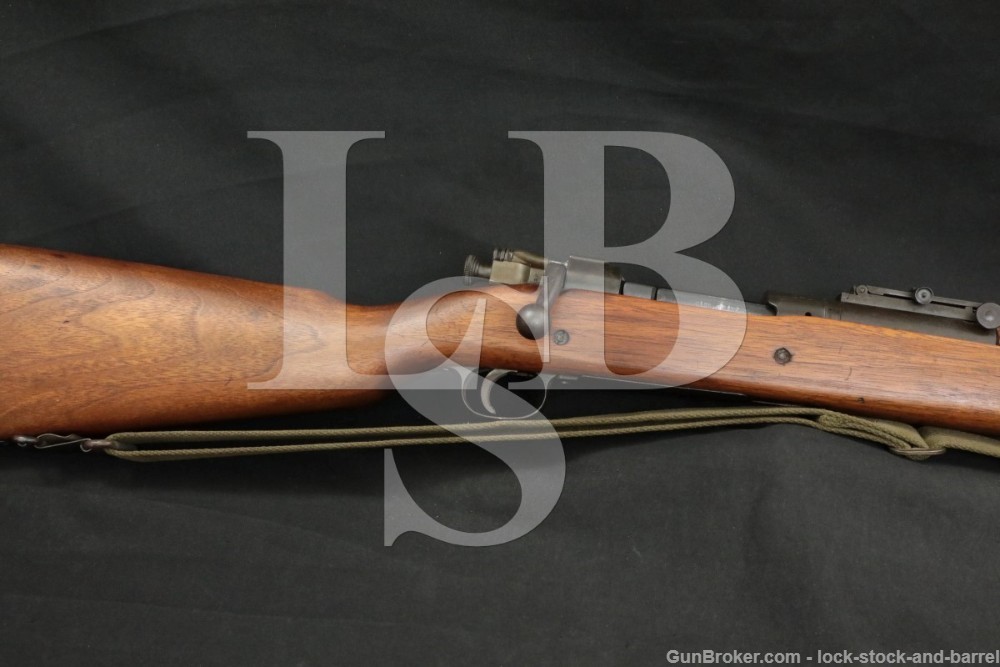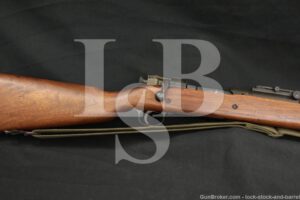
Springfield 1903 Mark I Pedersen Device .30-06 Bolt Action Rifle 1919 C&R
Sold For: $1,325.00
LSB#: 220627SH022
Make: Springfield Armory
Model: 1903 Mark I. The Mark I Rifle was made with an ejection port cutout on the receiver. The ejection port is needed for the Pedersen Device.
Serial Number: 1112240
Year of Manufacture: 1919 (page 373 of Joe Poyer’s book, The Model 1903 Springfield Rifle and its Variations, 3rd Edition).
Barrel Date: March, 1919
M1903 Mk I Rifles were produced from early 1918 to 1920 with a serial number range from 1,034,502 to 1,197,834 (page 31).
Caliber: .30-06 Springfield
Action Type: Bolt Action, Internal Magazine
Markings: The top of the receiver is marked “U.S. / SPRINGFIELD / ARMORY / MODEL 1903 / MARK I / 1112240”. The top of the Springfield barrel is marked “S A / flaming bomb / 3 – 19”. The safety is marked “SAFE READY” and the magazine cutoff is marked “ON OFF”. The bottom of the bolt handle is marked “R” for Remington and with a punch. The barrel band is marked “U”. The bottom of the grip is marked with a faded “circled P” proof. The left side of the stock, above the trigger, is marked with a faded stamping. The web sling is marked “NOBUCKL” and “PAT’D. 7.21.14” on the metal tabs. The rear sight protector is marked “P.J. O’HARE / SOUTH ORANGE N.J. / MADE IN U.S.A.”.
Barrel Length: Approximately 24 Inches
Sights / Optics: The front sight is a pinned blade set atop a raised base. The rear sight is a “U” notched blade attached to a fully adjustable sight ladder marked from “3-27”. When flipped up separate notches and an aperture on the ladder can be used for sighting. Metal sight protectors are installed.
Stock Configuration & Condition: The two piece hardwood stock has a straight grip, metal nosecap with bayonet lug, stacking loop, barrel band, 2 sling loops, 2 through bolts, and a metal buttplate with hinged door for storage. The buttplate and stock hardware show discoloration from oxidation and scratches. The buttpalte also shows light surface erosion. The wood shows several scrapes, scratches and compression marks. Many of these marks have been finished over. The most prominent marks are on the handguard. The LOP measures 12 3/4 inches from the front of the trigger to the back of the buttplate. The stock rates in about Very Good Plus overall condition as refinished.
Type of Finish: Parkerized
Finish Originality: Refinished
Bore Condition: The bore is gray. The rifling is deep; less pronounced at the muzzle. There is erosion in the bore. It is heavier in the grooves and at the muzzle. The bore shows an M.E. of 2.
Overall Condition: This rifle retains about 92% of its metal finish as refinished. The metal shows scrapes and small scratches. The barrel and receiver have been touched up with black gun paint. The gun paint on the receiver has surface erosion bleeding through causing discoloration. The bottom metal shows light oxidation. The screw heads show use. The metal markings are well defined. The markings on the wood are faded. Overall, this rifle rates in about Very Good Plus condition as refinished.
Mechanics: The action functions correctly. We did not fire this rifle. As with all used firearms, a thorough cleaning may be necessary to meet your maintenance requirements.
Box, Paperwork & Accessories: The rifle has a web sling attached. The rifle has sight protectors installed. There is a plastic oiler tube stored in the butt.
Our Assessment: When the US Army was looking for a rifle design to replace the 1898 Krag rifle, they looked directly at the Spanish Model 1893 Mauser. This was due to the fact that the performance of the Model 1893 Mauser was far superior than that of the 1898 Krag during the Spanish-American War. The Model 1903 is basically a redesigned Mauser clone. A U.S. Patent Court eventually found that the U.S. Army had violated Mauser’s patents and required the U.S. Army to pay the German Mauser manufacturers patent royalties. Payments were stopped once WWI started. The 1903 has a strong reliable action that served the Army for over thirty years in two world wars.
The 1903 Mark I was made to accept the Pedersen Device. The Pedersen Device replaced the bolt assembly and accepted a 40 round .30 caliber (pistol caliber) magazine. The cutout on the left side of the receiver is an ejection port. The Pedersen Device was meant to multiply the firepower of the individual rifleman. The rifleman carried 5 magazines for a total of 200 pistol caliber rounds. This was ideal for clearing trenches. Luckily WWI ended before the Pedersen Devices could be used in the trenches.
For an informative video on the Pedersen Device and its accessories see youtube.com/watch?v=wLzdGPzHL8U .
This collectible Springfield Armory Model 1903 Mark I Rifle was made back in 1919 so it was around for all of WWII. It is over 100 years old and is historically significant. The rifle has clear Springfield markings on the receiver and barrel as well as a deep “MARK I” designation on the receiver. The rifle comes with a web sling and sight protectors. This 1903 Mark I is worth adding to your collection. Good luck.

